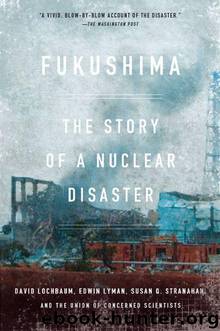Fukushima: The Story of a Nuclear Disaster by Lochbaum David & Lyman Edwin & Stranahan Susan Q

Author:Lochbaum, David & Lyman, Edwin & Stranahan, Susan Q. [Lochbaum, David]
Language: eng
Format: azw3
ISBN: 9781620971185
Publisher: The New Press
Published: 2015-02-09T16:00:00+00:00
On the opening day of the school year on April 6, 2011, a first-grader puts on her hat during an elementary school enrollment ceremony in Iwaki, Fukushima Prefecture. Despite the ongoing nuclear crisis, parents and school officials worked to create a sense of normalcy for children. AP
Public anger in Fukushima surged on April 19 when the government authorized schools in Fukushima Prefecture to reopen provided that students attending them would not receive annual radiation doses of more than two rem. The authorities must have thought they were on solid ground with the new dose limit. After all, the government had already decided it was safe for everyone, including children, to live in areas with radiation doses of up to two rem per year. But the announcement led to puzzlement and outrage.
The government argued that students would not actually be exposed to the maximum possible radiation levels because most of their time would be spent not in the schoolyards but inside the school buildings, where they would be shielded from radiation. Not only did the public reject that explanation, but larger questions arose. If there were schoolyards in the prefecture that were so heavily contaminated they might exceed the two rem per year standard, why weren’t the surrounding areas evacuated?
Another issue was why the government would allow children to bear the same radiation dose as adults. In doing so, the authorities were ignoring that children are particularly vulnerable to the harmful effects of radiation. The implications, once they sank in, set off a tempest of national protest.
A damning response came from Toshiso Kosako, a respected researcher who was serving as special advisor on radiation safety to the cabinet. On April 29, Kosako tearfully resigned at a news conference and delivered an angry statement criticizing the government for its “whack-a-mole” attitude in setting radiation safety standards. “I cannot possibly accept such a [dose] level to be applied to babies, infants and primary school students, not only from my scholarly viewpoint but also from my humanistic beliefs,” Kosako wrote.
In late May, the government announced it would revert to the usual standard of one hundred millirems (one millisievert) per year. And Tokyo promised to help pay for removal of contaminated topsoil from school grounds.
In many communities, residents eager to move on with life had already launched cleanup campaigns of their own, not willing to wait for the government. Scraping away just three inches of soil could reduce radiation levels by as much as 90 percent, so volunteers dressed in hazmat suits and paper face masks used earthmoving equipment and hand shovels to strip contamination from playgrounds and other public places. They handed over to their communities thousands of pounds of radioactive dirt, covered with plastic sheeting or stuffed into garbage bags.
Clearly, water was not the only by-product of the accident that would pose disposal problems. By one official estimate, as much as 695 square miles (1,800 square kilometers) in Fukushima Prefecture—more than double the area of New York City—was contaminated with enough radiation to yield an exposure level of five hundred millirems (five millisieverts) or more per year.
Download
This site does not store any files on its server. We only index and link to content provided by other sites. Please contact the content providers to delete copyright contents if any and email us, we'll remove relevant links or contents immediately.
| Alternative & Renewable | Drilling Procedures |
| Electric | Fossil Fuels |
| Mining | Nuclear |
| Power Systems |
Whiskies Galore by Ian Buxton(40277)
Introduction to Aircraft Design (Cambridge Aerospace Series) by John P. Fielding(32327)
Small Unmanned Fixed-wing Aircraft Design by Andrew J. Keane Andras Sobester James P. Scanlan & András Sóbester & James P. Scanlan(32134)
Craft Beer for the Homebrewer by Michael Agnew(17437)
Turbulence by E. J. Noyes(7031)
The Complete Stick Figure Physics Tutorials by Allen Sarah(6627)
Kaplan MCAT General Chemistry Review by Kaplan(6043)
The Thirst by Nesbo Jo(5775)
Bad Blood by John Carreyrou(5759)
Learning SQL by Alan Beaulieu(5396)
Weapons of Math Destruction by Cathy O'Neil(5027)
Man-made Catastrophes and Risk Information Concealment by Dmitry Chernov & Didier Sornette(4723)
iGen by Jean M. Twenge(4692)
Digital Minimalism by Cal Newport;(4501)
Life 3.0: Being Human in the Age of Artificial Intelligence by Tegmark Max(4490)
Audition by Ryu Murakami(4089)
1,001 ASVAB Practice Questions For Dummies by Powers Rod(4033)
Electronic Devices & Circuits by Jacob Millman & Christos C. Halkias(4014)
Pale Blue Dot by Carl Sagan(3993)
